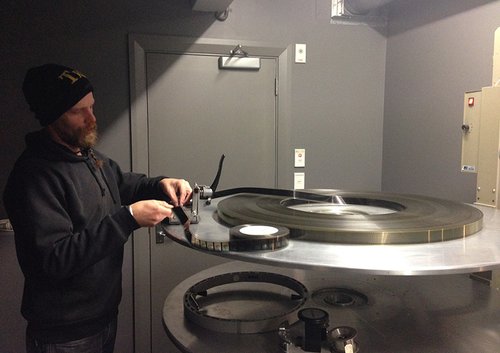
This post belongs to a two-part series. Read the first part, Projecting Film 100 Years Ago: The Motion Picture Handbook.
Oscar has a high degree of expertise when it comes to film projection, having been working in the field for over twenty years. His skills are in high demand: as well as working for Ngā Taonga Sound & Vision, he has projected films for a number cinemas and festivals in Wellington and elsewhere in New Zealand. Speaking to him, I was struck by the same level of perfectionism that was a feature of the 1915 Motion Picture Handbook: A Guide for Managers and Operators of Picture Theatres, which was the subject of an earlier blog – a precise nature must be a prerequisite to be a projectionist!
Hero image: Oscar working at the platter.
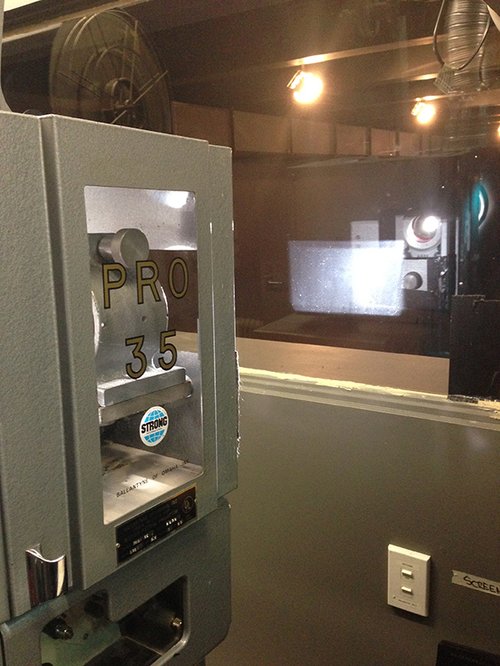
Projecting 35mm film in the Ngā Taonga Sound & Vision projection booth.
Oscar Halberg: As an audience you don’t see the booth, you don’t really think about how that image is put on screen, and how much work does go into that. I can’t tell you the amount of people that used to say to me “what do you do for a job?” and I’d say “I’m a projectionist,” then roll my eyes because typical responses are: “Oh you must get to see all the movies then! What did you think about so-and-so?”, or “you just put a tape in and press play, right?”, thinking it’s like VHS at home, which – of course – it isn’t. And I tell them “It’s a little bit more complicated than that,” and then you have to get into the whole “It’s in 20 minute reels, and you have to join all of those reels together.” You get to see the first five minutes and the end. You always see the end before you see the beginning, which was one of the reasons why I hated Pulp Fiction (1994) for the longest time, because I just couldn’t justify the fact that the opening scene was the same as the closing scene!
Ellen Pullar (Digital Programme Developer, Ngā Taonga Sound & Vision): When did you decide to become a projectionist? How long have you been doing it?
Oscar: 23 years. Since 1992, when I started my apprenticeship. I haven’t always worked as a projectionist, but there’s never been more than three or four months where I haven’t had to project a film. Though probably in the last three years I’m doing less and less 35mm work, it’s all digital. The interesting difference between digital and 35mm is clearly it’s not as physical – you’re not lifting film around all the time and carrying prints. But you still do the same sort of work, you just go about doing it differently – so instead of using a splicer, I use a mouse. Though a feature in the digital sense is full and complete. It is assembled in the same way, digital film still has reels. So they’ll have reel one, with visuals and the audio soundtrack, and then they’ll have, reel two and three – but they’re all joint together as what they call a “Digital Cinema Package” or “DCP.”
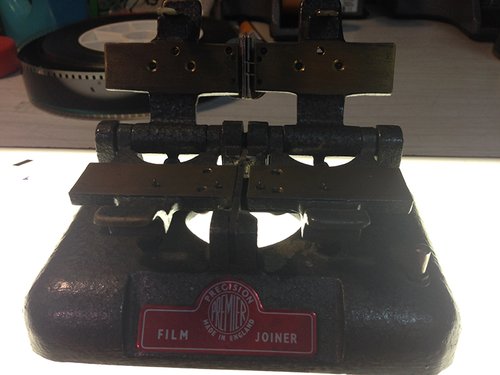
A film joiner, used to repair broken film.
Ellen: So it can’t be that one part gets damaged or corrupted?
Oscar: It can be, which is really interesting. It doesn’t happen very often, but you might be missing a CPL, which is basically the part that attaches to the KDM [the code to access the encrypted film], on one of more of your reels. So sometimes that can be a bit of a hassle. It means you have to ingest the film again. Unfortunately I can make up a 35mm print in about 45 minutes – I can even shave that, if I need to, by taking some shortcuts, which I don’t really like to take – so I can get a film off the plane, from the airport, on screen in say an hour and a half. You can’t do that with a digital file. You’ve got to wait for it to ingest, and that usually takes an hour and a half to two hours. If the projector is projecting something else it’s going to take longer because of the amount of RAM that can be used – most of it’s being used to project the image, so you can’t use it to ingest the film. So it takes a really long time!
Ellen: And with DCP you only have access to the film for a certain amount of time in which to make sure it’s going OK, project it, and then it is shut off?
Oscar: Yes, that’s what the KDMs are for. They give you a specific window of time when you can play it, and then you can’t access it. For example, I just had a screening of Spongebob over at the Embassy this morning that I needed to check last night. The KDM for that was open for 31 hours, which enabled me to test the content, make sure it was there and that it was going to work, and they’ll screen it today, then by the end of today that content will be closed and they won’t be able to screen it. This is part of the reason why cinema has gone digital – the resolution on a 35mm print is still, for the most part, better than the resolution on digital – but there are shipping costs. A feature would usually be about 25kg, so there are costs associated with shipping something that size and weight.
Ellen: And to have multiple copies of it.
Oscar: Exactly. A print copy would be let’s say $35,000, versus a hard drive, which is $200. So it’s a lot cheaper for the distributors.
The only unfortunate thing is the earliest DCPs, you can’t play those anymore. But I can still play a 35mm print from ten years ago. This film that we’re going to run today [Gallipoli: The Frontline Experience] is from 2005, two years later you’d start to see DCPs, but I can’t play any of them from 2007 because the codecs, the firmware, has upgraded to the point that it can’t be played anymore. But I can still play film as long as I’ve got a 35mm projector.
So this film projector that we have in here is from the early 1980s. We’re also looking at getting two new [second hand] projectors because the components in this machine are starting to wear out, and we don’t have spares. There’s probably not so much now, but a couple of years ago a lot of 35mm equipment was floating around on eBay, people just trying to get rid of it to scrap dealers. The metal components were worth more than the actual projector was itself, which is such a shame because they’re beautiful machines, they can run and run.
I used to work at the Penthouse for a while, and they had two projectors that were as old as my Dad – they were built in 1952. They were called Phillips (which is Kineton before it was Kineton, one of the major brands of projectors that New Zealand uses). They projected beautifully, as if they were five years old. At 50 years old the image was just as good as any of the contemporary machines. There was a certain amount of automation on them as well, so they could upgrade these projectors to work with automation. At 50 years old! You’d never get a digital projector to work in 50 years – this machine here [the DCP projector] will be as useful as a paperweight in 50 years time, whereas the 35mm projector sitting next to it, that will still work.
Ellen: Its components last a long time?
Oscar: At my first job we had spare parts to almost build a completely new projector, so we always had the parts we’d need in an emergency on hand, which is something that you can’t get with digital. Digital projectors are ridiculously expensive inside – the engine inside a digital projector is probably about $50,000 – so if you damage that by having an exploding lamp it’s going to be very costly, and it will shut you down for a long time while you’re sourcing replacement components, which you just won’t have on hand. But the service of a 35mm projector was always pat of the projectionist’s job. Though you would have a company that would come and do a service for you each year too – and they also do the automation, allowing a projectionist to run multiple screens at a given time. One of the things I like about here is there’s only one screen!
Ellen: So you don’t have to run around as much.
Oscar: Although I would quite like doing reel-to-reel changeovers [between two projectors or cinemas]. In my career I’ve only done a dozen maybe reel-to-reel changeovers. You always hope that you get your timing right. That’s what the cigarette burns are in the corner. They’re cues – when you see the first one, you start up the secondary projector.
Ellen: How much time do they give you?
Oscar: Usually it’s eight seconds between cues. So when you lace your leader you see numbers, which then disappear, and usually there’s a section of black on there. Depending on whether it’s an eight-count or a ten-count leader. They have a “Start Picture” icon, so you’ll have that laced in the gate for reel-to-reel changeover, and once you see the first cue you’d start that projector, and this gives you eight seconds.
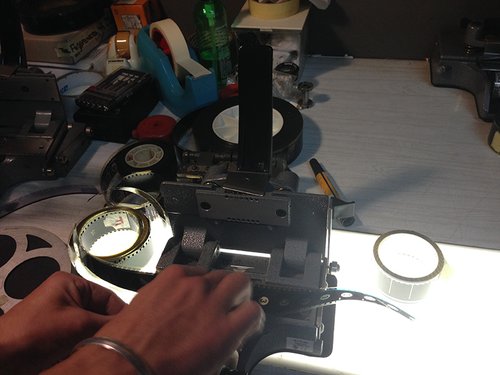
Oscar splicing a leader onto a film - the number 3 is visible, counting down the seconds until the film starts.
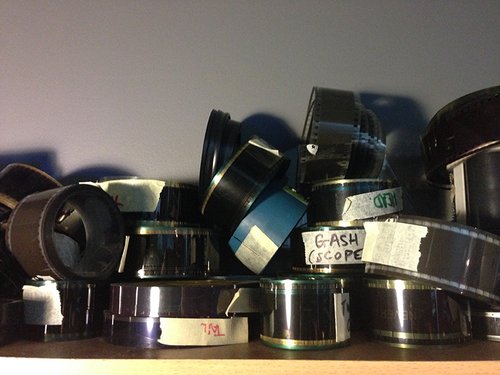
Spare leaders and tail pieces on Oscar’s work bench.
Ellen: Eight seconds is not very long!
Oscar: No – that’s why your timing has got to be great. You’d shut the dowser on the principal projector that’s projecting, and open the dowser on the other machine. If you do that seamlessly it will run into black just as the other image is coming on screen. So the audience is unaware!
Initially, it was 20-minute reels so you’d do maybe five changes for an hour and a half feature. Then someone went “well, we can make larger spools.” So you have what we call a 1,600-foot spool. So with that I can get about an hour’s worth of film in three reels. Instead of having five changeovers per film I just have two.
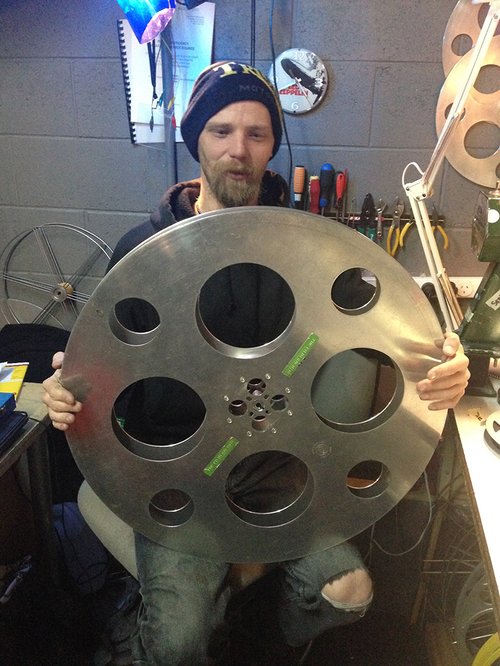
Oscar with a 6,000-foot spool.
Ellen: It must be very heavy when it’s full of film.
Oscar: Yes, probably when that’s full of film it would be somewhere in the vicinity of 15kgs. You do a lot of wheeling!
Ellen: It must be quite tough on your back, lifting these around.
Oscar: Lugging film around was one of those things where you needed a bit of physical energy. I’m nowhere near as strong as I used to be – I don’t lift film much anymore, I lift hard-drives, which weigh nothing!
The old film cans themselves are quite heavy, and then they’re filled with probably an acetate film stock – which is a little bit denser than polyester film stock, therefore a little heavy. Then you’ve got these metal handles that will bust into your fingers. They’re really uncomfortable to carry, those travel cases. You know, run five metres, put them down! And you need your fingers as a projectionist. Because you do things like this [moves over to platter]. I might just do some work while I’m chatting.

Oscar working at the platter.
This is a leader and a trailer. It’s how we used to do advertising. You’d have your trailers of “Coming Features,” maybe some slide advertising for the local businesses. In Palmerston North, where I did a lot of my early work, the owner of a business (who had great foresight), worked out a deal with the local cinema where they’d play this ad for I think it was 42 years. I think they still do in fact play that ad!
So this is a splicer, which you use instead of a razor blade, with film cement. A problem is that sometimes the sprocket holes don’t punch out, and what can happen is they can come out and stick to the film further on, and the film will wrap up and not unreel. Reel-to-reel is better for that in some regards because you’ve got gravity working with you: it’s vertical and the film’s running off the spool, so there’s that neutral weight. Platters, being horizontal, it’s a lot more likely that the film will stick on one of these giant film reels.
These platters were first developed – this is useless information, but it’s kind of interesting – for drive-through cinemas so that they could play a big programme. They’d often back up a feature so they could play double features, they were constantly rewinding and relacing projectors. Somebody said “there’s got to be a better way to do this – what if we put film horizontally, on a massive reel?” So they put it on a table set-up, where it’s pulled off that table through to a projector, then wraps up on itself again. So it’s also rewinding itself as it plays, which is why I pulled the centre out – this is the start of the film and as it plays it will go out to the edge and wrap up on itself again. As soon as it’s finished playing it’s ready to play again, whereas with reel-to-reel, once it’s played through the projectionist has to take the film and rewind it.
It is reasonably labour-intensive, at the same time as having to keep an eye on your carbon arcs, how much film you’ve got before your next changeover… One of the biggest things in projection is time-management. Knowing how long it’s going to take you to do something, and when you’ve got time to do it.
Ellen: You’re a good multi-tasker.
Oscar: So this is what we used to do to change ads [changes centre section of film on platter]. Of course, advertising changes weekly, but your programme might run for eight weeks. Instead of pulling the whole thing apart and changing the ads on the spool they devised these things called ad-spinners. The first one I saw was devised by the Senior Projectionist, my main training officer, he actually created this perspex round, it would sit in the middle of the platter, with a little handle onto it so you could wind the film onto it. Take it off and it would also fit onto the rewinding machine, so it saved a lot of time. This was probably 20 years ago. Then one of the engineering companies saw this thing and thought “we can make quite a lot of money out of this thing,” so they started making and selling them through the cinemas, enabling them to change the ads, which saved a lot of time.
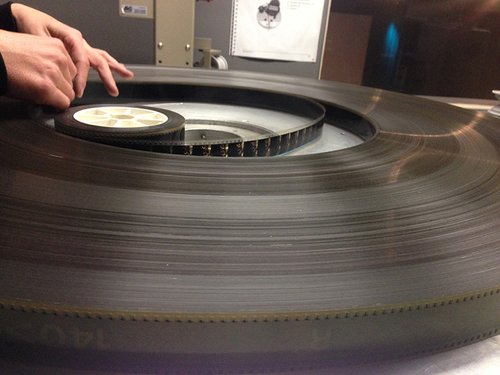
Changing the ads on the platter.
Ellen: So when was the moment you decided to become a projectionist? You told me earlier that your grandfather was a projectionist – was it working with him?
Oscar: I first got into it then. I’ve always enjoyed entertainment, I used to be a child actor – mostly on stage. Acting was always something I enjoyed. And I’m an artist, so I love anything that has a visual aspect to it. I also like the tactileness of film, the way it feels. I have good film handling skills, I’m very good with understanding what it’s going to do – so I can predict it
There was this little argument when I first started about whether to run soundtrack to the bottom or soundtrack to the top on the platter, and I always maintained that the bottom was better because then the emulsion is mostly protected. Running the soundtrack with the bottom down runs the emulsion in. So if anything were to fall onto the platter and scratch the film, it’s not ripping emulsion off the film. In terms of how you reel film, we tend to go emulsion out here, which I dislike because it means I have to double rewind things so I can have my soundtrack down on the deck – it’s just a projectionist’s preference thing. The whole tail-out thing was one of those accepted rules between projectionists that it would be done this way – it makes it easier for everybody because it’s uniform and consistent. But with the advent of automation, and making things simpler, and not needing the training – the understanding of how the equipment works – in the last years of 35mm it was quite common to get things higgidly piggidly. So you’d get one reel head-out, one reel tail-out, one reel emulsion-in, one reel emulsion-out.
So you’d spend a lot of time figuring out how to assemble the print, and that was largely because of makeup tables like this grey one beside the platter, what you call a MUT. It’s very simple, very basic, very little control. There’s an infra-red censor on it, which is this roller. And this roller’s supposed to tell the platter what the back-tension on the film should be, and adjust the speed it spins at. The problem with these is if you’ve got any slack, that’s going to pull and then smack on that roller really hard. These triangle-shaped rollers can yank the film down there, and, because it’s strong polyester, it doesn’t break. If it was acetate it would break, which would be an annoyance, but at least it wouldn’t necessarily damage the film – you could splice that back together.
Ellen: So it stretches it?
Oscar: Because polyester is pretty much indestructible, yes, it can stretch it. There’s stories where polyester film has actually pulled out platters (which are bolted into the floor) because it’s so strong. Or it can buckle in the sprockets. Then as a projectionist you need to gauge whether to leave the damage in – whether or not it’s going to mess with the integrity of the film – or whether to chop out those frames. But I don’t like chopping of bits of film off prints, because they’re so few and far between now that we need to look after what we have.
When I was working in Palmerston North we used to get a lot of prints out of Australia, which had already gotten around the back Outback, and they were in quite bad shape. Some of the worst prints I’ve come across actually are Bollywood films – just because of the amount of screenings they’ve done, by the time they’ve been all around India and Sri Lanka and Pakistan. You can spend hours just tidying and cleaning up bad prints.
Ellen: This is the 35mm projector and beside it is the DCP one?
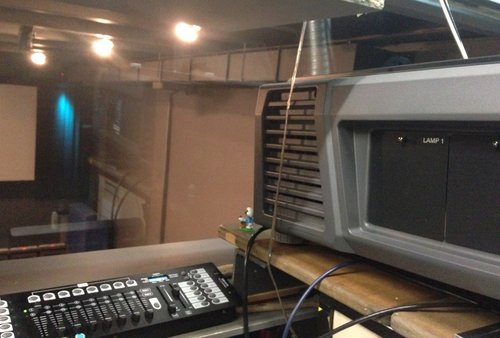
The DCP projector.

The 35mm projector.
Oscar: [Opens up 35mm projector.] The 35mm machine is rather nicer! Inside it has got an electric motor (that runs your sprockets), and a shutter that runs behind and cuts the light off as the next frame advances.
Ellen: All of these components explain why the Motion Picture Handbook was so big on electronics.
Oscar: Yes, and a bit of mechanics also helps, because you’re dealing with a belt system. I did do quite a bit of electronics, I’ve always been fascinated by it.
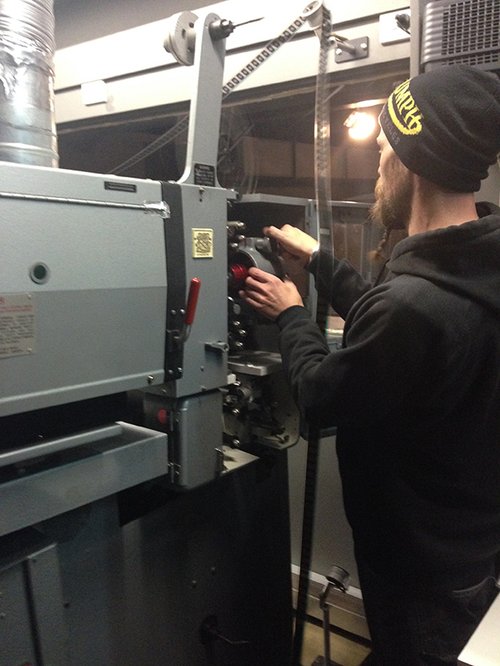
Oscar working inside the 35mm projector
Ellen: So your training was a combination of on-the-job as an apprentice, exams, electronics courses, and what else?
Oscar: When I was in high school I was interested in electronics, so I did some courses. I also started an apprenticeship as an electrician. I hated it! But then I had the opportunity to come back to projection, and I got my Operator’s Certificate. I did a two-year projection apprenticeship. It’s much less than that now – you get maybe two-weeks on the job training? Working with other projectionists is really valuable, but now it’s so condensed – which is why films get damaged a lot more frequently, because they don’t have the same care and attention, film handling… For the first year of my apprenticeship I did not assemble any films for projection, all I did was break down content – “so you’re finished with that programme? Now Oscar’s allowed to work on it.” In that way I learnt to handle film, then once I was confident with film I was allowed to start doing programmes. One of the first programmes I did with them, I think, was Titanic (1997). Our print was still in really good condition after 23 weeks. It was all we had, and it wasn’t damaged or scratched.
Ellen: What would you say one of the main changes has been for you with the shift to digital?
Oscar: Having to understand computers a lot more! The light-management is a lot different as well – they have focusing wizards and light-management wizards. You sort of just tap “go” and it does all of that for you, whereas with 35mm I’d have to do that all by touch and feel and sight. You know, I’d put the light on the screen with 35mm and adjust the light parameters so there was no shadow. When you’re running a 35mm projector with the lamp on you’ve got to have the shutter working, otherwise that can burn out the lens, which is something I don’t really understand about the digital lenses – how they can have constant light going through them and not have any damage. They’ve just created, over the last couple of years, a laser projector, so that’s a big change.
The term “motion picture” doesn’t actually apply to digital because it’s pixels with light, assigned a colour value. So those pixels are always on screen, the only thing that is changing is it’s assigned colour value – one might go from yellow to green to blue, and the one next to it from white to blue to green. So you don’t have that illusionism of looking at a static image, but being fooled into thinking it’s moving.
The actual, physical working with film doesn’t happen so much anymore. It’s working with hard drives, ingesting hard drives onto servers, putting a KDM on it so you can use it. Part of the reason they have KDMs is so the distributor has complete and utter control over when something is being screened. With a 35mm print, I can screen it whenever I’m ready to screen it.
Ellen: With KDMs, we’re not going to hear anymore stories about former projectionists’ film collections being discovered.
Oscar: No. Well, if you do, they’ll be encrypted! So you wouldn’t be able to play them without going to the distributor and getting the encryption codes to make the KDM work. Although those KDMs have been hacked already – so if you’re a smart enough computer hacker you can steal a DCP and play it. Piracy is clearly a massive issue for the cinema industry. Today’s generation don’t necessarily consider internet downloads to be illegal. They don’t always understand “you may look, but you can’t hack.”
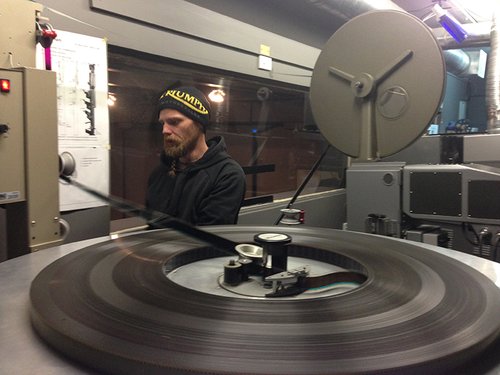
Lacing the film from platter to projector.
What I’m doing here – this is called a feed-out assembly [demonstrates lacing through of film from platter to projector] – the infrared censors I was telling you about feed the film through at a constant speed. This is not actually mechanized, they do require a bit of supervision. This film I have laced is ready for continuous play. With digital you can actually have continuous play by way of looping the show in the controls.
So I’m lacing the film through the gate soundtrack facing me – see how “Start Picture” and “8” is upside-down. It works very much like an eye lens – a lot of people don’t realize that humans see upside-down. So all the images are being presented upside-down, and it’s our brain that re-inverts the image, so it’s the right way round. The lens works in the reverse of the way the human eye works, which is why I think film is a lot easier to look at than digital projection. Also the blue light damage that devices like your cellphones and computers can cause to the eye – you don’t really get that from film – well Xenon lamps [used in this 35mm projector] are a blue light, but the carbon arcs we used to use were a pure white light, which is actually better for you. With 35mm they put a yellow colour filter between the Xenon and the image, which takes a bit of the blue out. Also, for every 24th of a second there’s a shutter, which works as a natural eyelid, so you’re not looking at constant light all of the time. Some people reckon they can detect that flicker, but they can’t – what they can detect is lateral movement of the film in the gate.
I, personally, love the whir of the film in the projector. I feel comfortable when I hear it, when I don’t hear it, I think “what’s going on?” I miss it. Digital projectors whir a little, because of their fans, but otherwise they’re silent.
I’ve always had some digital interaction. I mean the first video projectors were being created when I was doing my training – I’ve worked with just about every type of projection you can think of – slide, video, laserdisc, DVD, Blu-ray…
Ellen: Have you ever projected nitrate film?
Oscar: Yes, at the Foxton Film Museum. It was only a section of maybe three minutes. I had to beg, basically, to do it! In my training the older projectionist was quite adamant that I should at least have a rudimentary understanding of what would happen if I did have to work with nitrate, so he found some old nitrate, and showed me how inflammable it is.
Ellen: Your training sounds very comprehensive – it sounds like you learnt everything in the Motion Picture Handbook!
Oscar: Yes, I wonder if they had a book similar to that to teach me from?
Ellen: This copy of the book was owned by the projectionist at the Regent Theatre in New Plymouth.
Oscar: The Regent Theatre in New Plymouth was actually a theatre that my training guy worked for.
Ellen: I looked at two editions of the book, one from 1912 and one from 1915. In 1912 he talks about freely changing the projection speed if you felt that a scene needed to be slower or faster for emotional impact. But by 1915 that has disappeared, and he seems to believe in preserving the integrity of the director’s work – not speeding it up or slowing it down to try and improve it!
Oscar: I did do it once, a Buster Keaton film. There’s a bit in it where there’s a tornado. The film was from the 1920s, but that tornado needed to be slowed down in terms of frame rate. So in the middle of the film I had to adjust the frame rate on the projector.
Ellen: Is it easy to do on the fly?
Oscar: Not technically. But we knew we were doing variable speeds for that film, so we devised a switching unit for the projector, which would slow down the current to the electrical node and decrease the frame rate.
Ellen: It seemed to be pretty acceptable in 1912 to just speed up and slow down the film.
Oscar: Well it was actually quite acceptable in the 1990s as well – a lot of cinemas would increase their frame rate to 25 frames per second, which would save on a hour-hour film about two minutes! So they could squeeze in an extra sitting.
Ellen: Well, I should probably let you get ready for your screening at 7pm. So I’ll just ask you one more quick question – what is your favourite part of your job?
Oscar: I really really like the tactile nature of working with film. So Ngā Taonga Sound & Vision is a very good place for that. I was so excited when I got the opportunity, because I was aware at the time that everything was going digital, but I knew that, being a film archive, we’d still have film.
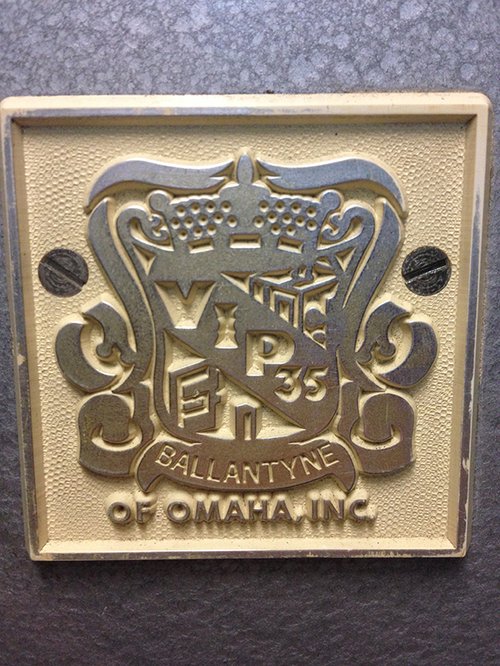
Crest on the 35mm projector.
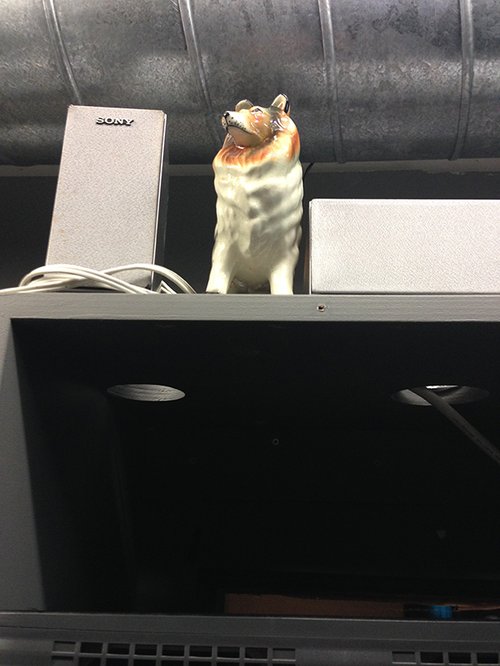
Oscar’s projection companion, Lassie.